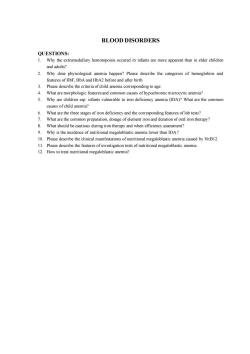《儿科学》课程作业习题(复习题)05 questions of blood disorders

BLOODDISORDERSQUESTIONS:Why the extramedullary hemotopoisis occured in infantthan in elder childrennd adultsWhyoglobinsandfeatures of HbF,HbA and HbA2before and after birthPlease describe the criteriaofchild anemiacorrespondingtoageWhat are morphologic featuresand common causes ofhypochromic microcytic anemia?Why are childrenesp. infants vulnerable to irondeficiency anemia (DA)? What arethe commonofchildanWhat are the three stages of iron deficiency and the corresponding features oflab tests?What arethecommon preparation, dosageofelement iron and duration oforal irontherapyWhat should be cautious duriron therapy and when efficiency assessment?Why is the incidence of nutritional megaloblastic anemia lower than IDA ?sed byVitB12.PleaotatofnutritionalmegaloblasticPlarnutritionalmegaloblasticanemiaHowtotreatnutritionalmegaloblasticanemia?
BLOOD DISORDERS QUESTIONS: 1. Why the extramedullary hemotopoisis occured in infants are more apparent than in elder children and adults? 2. Why dose physiological anemia happen? Please describe the categories of hemoglobins and features of HbF, HbA and HbA2 before and after birth. 3. Please describe the criteria of child anemia corresponding to age. 4. What are morphologic features and common causes of hypochromic microcytic anemia? 5. Why are children esp. infants vulnerable to iron deficiency anemia (IDA)? What are the common causes of child anemia? 6. What are the three stages of iron deficiency and the corresponding features of lab tests? 7. What are the common preparation, dosage of element iron and duration of oral iron therapy? 8. What should be cautious during iron therapy and when efficiency assessment? 9. Why is the incidence of nutritional megaloblastic anemia lower than IDA? 10. Please describe the clinical manifestations of nutritional megaloblastic anemia caused by VitB12. 11. Please describe the features of investigation tests of nutritional megaloblastic anemia. 12. How to treat nutritional megaloblastic anemia?
按次数下载不扣除下载券;
注册用户24小时内重复下载只扣除一次;
顺序:VIP每日次数-->可用次数-->下载券;
- 《儿科学》课程作业习题(复习题)04 questions of circulatory system.doc
- 《儿科学》课程作业习题(复习题)03 questions of respiratory diseases.doc
- 《儿科学》课程作业习题(复习题)06 questions of nervous system.doc
- 《儿科学》课程作业习题(复习题)10 questions of infectious diseases.doc
- 《儿科学》课程作业习题(复习题)09 questions of endocrine disorders.doc
- 《儿科学》课程作业习题(复习题)07 questions of urinological system.doc
- 《儿科学》课程作业习题(复习题)08 questions of immune system.doc
- 《儿科学》课程教学资源(授课教案)12 Acute Glomerulonephritis,Nephrotic Syndrome.doc
- 《儿科学》课程教学资源(授课教案)11 Acute Convulsion in Children.doc
- 《儿科学》课程教学资源(授课教案)13 Immunodeficiency.doc
- 《儿科学》课程教学资源(授课教案)10 Nutritional Iron Deficiency Anemia.doc
- 《儿科学》课程教学资源(授课教案)15 Growth Hormone Deficiency.doc
- 《儿科学》课程教学资源(授课教案)14 Congenital Hypothyroidism.doc
- 《儿科学》课程教学资源(授课教案)17 Varicella.doc
- 《儿科学》课程教学资源(授课教案)16 Measles.doc
- 《儿科学》课程教学资源(授课教案)19 Tuberculosis Meningitis.doc
- 《儿科学》课程教学资源(授课教案)20 Toxic Bacillary Dysentery.doc
- 《儿科学》课程教学资源(授课教案)21 Chronic Gastritis in Children.doc
- 《儿科学》课程教学资源(授课教案)18 Primary Pulmonary Tuberculosis.doc
- 《儿科学》课程教学资源(授课教案)24 Mumps.doc
- 《儿科学》课程作业习题(复习题)02 questions of neonatal diseases.doc
- 《儿科学》课程作业习题(复习题)01 questions of children healthcare.doc
- 《儿科学》课程作业习题(典型病例)06 nephrotic syndrome-2.doc
- 《儿科学》课程作业习题(典型病例)06 anute nepheritis-1.doc
- 《儿科学》课程作业习题(典型病例)08 diarrhea.doc
- 《儿科学》课程作业习题(典型病例)03 congenital heart disease-VSD.doc
- 《儿科学》课程作业习题(典型病例)04 iron deficiency anemia.doc
- 《儿科学》课程作业习题(典型病例)05 purulent meningitis.doc
- 《儿科学》课程作业习题(典型病例)07 congenital hypothyroidism.doc
- 《儿科学》课程作业习题(典型病例)03 congenital heart disease-TOF.doc
- 《儿科学》课程作业习题(典型病例)01 ABO incompatibility of neonates.doc
- 《儿科学》课程作业习题(典型病例)02 pneumonia.doc
- 《儿科学》课程作业习题(试卷和答案)双语试卷C卷(试题).doc
- 《儿科学》课程作业习题(试卷和答案)双语试卷B卷(试题).doc
- 《儿科学》课程作业习题(试卷和答案)双语试卷B卷(答案).doc
- 《儿科学》课程作业习题(试卷和答案)双语试卷C卷(答案).doc
- 《儿科学》课程作业习题(试卷和答案)双语试卷A卷(试题).doc
- 《儿科学》课程作业习题(试卷和答案)双语试卷A卷(答案).doc
- 《儿科学》课程教学课件(PPT讲稿)07 新生儿缺氧缺血性脑病 Hypoxic-ischemic Encephalopathy(HIE).pptx
- 《儿科学》课程教学课件(PPT讲稿)06 新生儿败血症 Neonatal Septicemia.pptx
